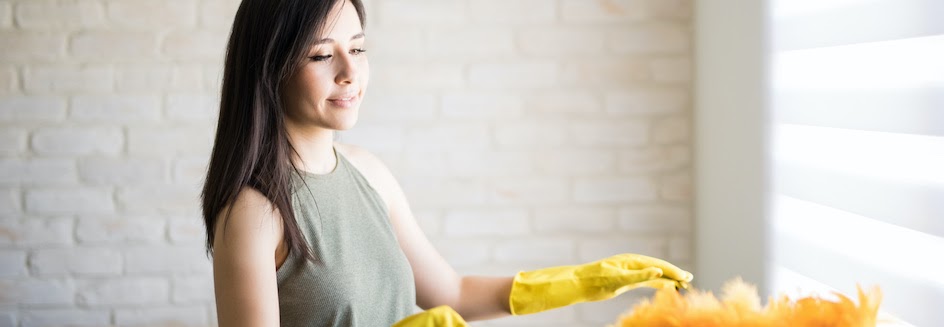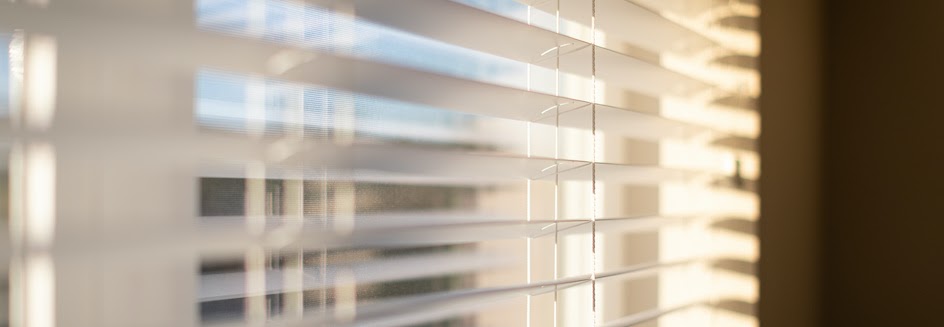Venetian blinds offer timeless style and improved privacy and light control in our homes. While we spend a lot of time and effort choosing the right materials and colours for our window dressings, many of us forget to maintain a regular cleaning schedule. Oftentimes, we’re unsure of the best ways to keep the horizontal slats clean or how often we should be cleaning them.
Here, we’ve put together a handy guide on how to clean aluminium venetian blinds and wooden blinds. We’ll offer tips for regular light cleaning and give you guidance on how to perform a deep clean in the event of stains or grime build-up. We’ll also show you the best way to clean your venetian blinds whether they’re of the aluminum variety or wooden venetian blinds.
How to Clean Venetian Blinds
The proper cleaning techniques for venetian blinds vary depending on the type of material used to make your blinds. For aluminum, PVC, synthetic blinds and other waterproof venetians, you can use warm water and wet cloths to remove heavy dirt and grime build-up. However, real wooden blinds may be damaged by water, causing the slats to warp and bend. For these types of blinds, it’s best to minimize the amount of water you use or to use a venetian blind cleaner specifically formulated for wood. Read on to learn more about how to clean venetian blinds.
Light Regular Cleaning
The horizontal slats of this type of blind can accumulate dust and dirt more easily than vertical blinds. Venetian blinds should be regularly dusted or vacuumed every week or so. The amount of time in between dustings will vary depending on where you live. People who live on busy city streets and keep the windows open often may have to clean venetian blinds more frequently. In general, it’s a good idea to lightly clean your blinds every time you start to see dust accumulate — usually about once per month — or when you're doing your other household dusting.
Here’s how to clean venetian blinds with a light regular dusting. Start by using a feather duster, a dry cloth or an old sock. Work your way from top to bottom, cleaning each slat individually. Make sure that you’re cleaning the entire slat, especially if you have wider slats such as the 50mm slat width.
Also, make sure to clean both sides of the slat. The best way to do this is to fold the cleaning cloth in half and grip the slats on both sides. Move the cloth across the slat, cleaning both sides of the blinds. Another way to do this is to close the blind slats completely and clean that side of the slats. When you’re finished, tilt the blind slats 180 degrees and finish cleaning the other side of the slats.
You can also use a vacuum cleaner to remove dust, though a duster or cloth reaches tight spaces such as the headrail or corded system more easily. When using a vacuum, make sure to use caution around any cords or wands to avoid causing damage. Always set the vacuum suction speed to low and use an upholstery attachment or an upholstery brush. Without the brush attachment, you may scratch the surface of your blind slats. Use the methods above to ensure you clean both sides of each individual slat.
Cleaning Minor Stains
Sometimes, your venetian blinds may develop stains. This is particularly common if you often leave your windows open or the blinds are in high-traffic rooms like kitchens and bathrooms. To clean these stains, start by identifying the type of venetian blind you have. If it’s made of real or faux wood, do not use water to clean stains. Instead, use a venetian blinds cleaner that states it can be used on the materials of your blind. If you use regular water or other cleaning products, you may stain or warp your blinds.
For aluminum venetian blinds and other waterproof styles, you can use a solution of water and vinegar to remove stains. Here’s how to clean venetian blinds that have stains:
- Combine equal parts warm water and vinegar in a medium-sized bowl.
- Dip a microfibre cloth or an old sock into the cleaning solution until it is damp.
- Run the damp cloth across the stain until it disappears.
- Use a soft cloth to dry the blind slats when finished
If your venetian blinds have stains near the headrail or the corded system, you can use a cotton ball or cotton swab to get into the small spaces. For stubborn stains, you can also use a soft brush in a circular motion. Just make sure not to apply too much pressure when scrubbing or you may break the blind slats.
If you don’t have any vinegar on hand, you can also use soapy water as an alternative. Make sure to use a mild detergent that is suitable for the surface material of your blinds. You can also use a mild window cleaning spray. Make sure to dry the blind slats completely when you are done cleaning.
Deep Cleaning for Stains and Grime
Your window blinds require occasional deep cleaning. Deep cleaning blinds requires removing them from their frame, meaning this cleaning process is time-consuming. Fortunately, you only need to do a deep cleaning when you notice significant grime build-up or when your regular cleaning isn’t getting the blinds as clean as you want them.
Aluminum, plastic and other metal venetian blinds are the only styles that should be deep cleaned since the process involves water. For blinds with wooden slats, stick to a regular light dusting and vacuuming to protect the blind materials. Here’s how to clean venetian blinds so they sparkle and shine like new.
Prepare the Area
Start by preparing your work area. You can deep clean blinds in the bathtub or outside using a garden hose. If you choose to clean them outside, lay down a towel or cloth to protect that blinds from scratches and dirt. If you’re cleaning them in the bathtub, use a rubber mat or towel to prevent the blinds from getting scratched.
Fill a bucket with clean water. You can use cold water if you’re using an outdoor hose or warm water if you’re working inside. You can add a mild detergent or vinegar in equal parts. Grab a clean cloth or another soft cleaning tool such as a microfibre cloth or non-abrasive sponge.
Remove the Blinds
Remove the blinds from the frame as indicated by the manufacturer’s instructions. Perfect Fit blinds can easily be snapped off from their frame and don’t require drilling or power tools for removal or installation. Other types of venetian blinds may need to be removed using a drill. Make sure to keep any hardware safe and remember which pieces go where for when you have to remount your blinds.
Start Cleaning
Take your blind and lay it carefully on the bathroom floor or on the prepared surface outside. Use the cleaning tool and carefully clean each slat individually, making sure to get both sides. When you’re done cleaning, rinse the blinds with cold water, paying attention to remove all soapy residue.
Dry the Blinds
Once you’re finished with the blind cleaning, you can dry the blinds. You can use a dry cloth to get most of the moisture and finish the process with a hairdryer set on a low setting. Don’t use high settings on the hairdryer as the heat may damage the blinds. You can also let the blinds air dry by hanging them on your fence or form a shower rail. If you choose to hang the blinds, make sure they are secured to avoid them falling and getting damaged.
Once the blinds are dry, remount the clean blinds according to the manufacturer’s recommendations.



